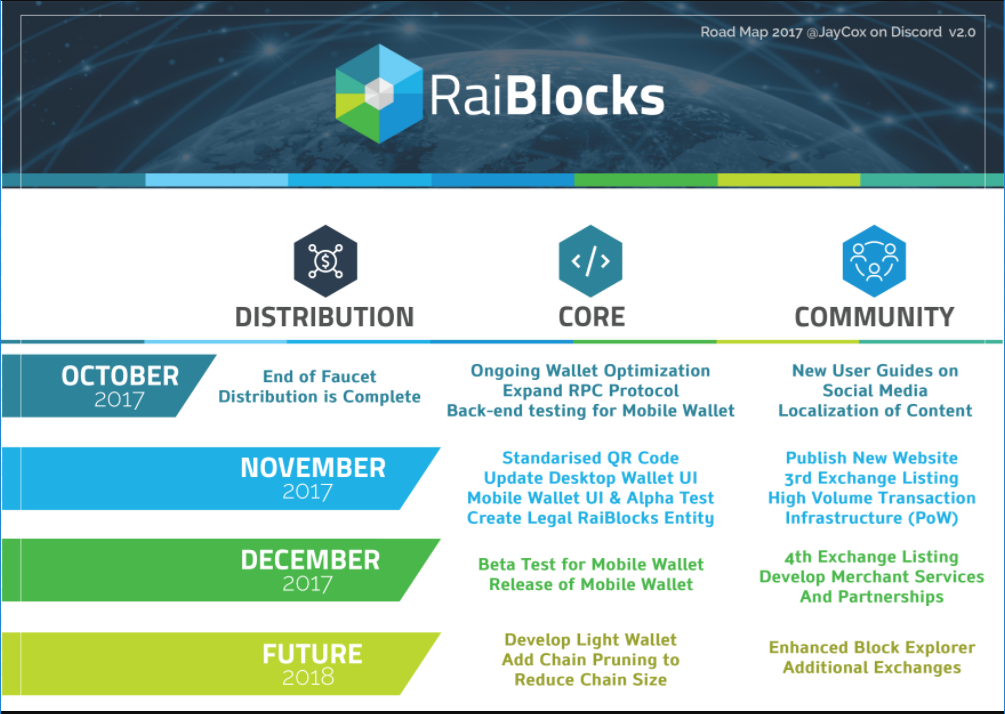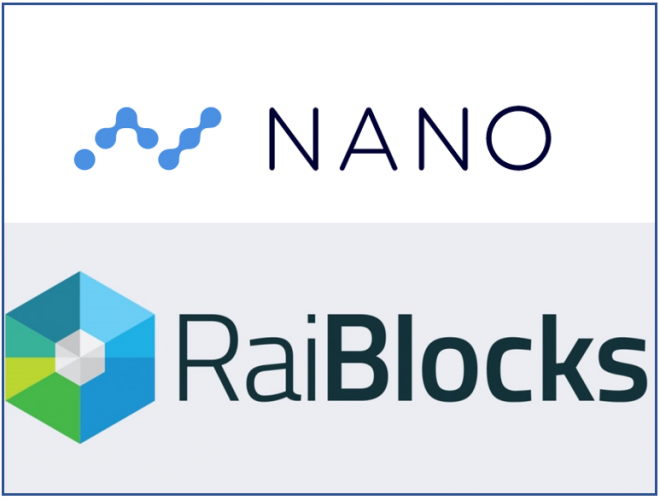If you’ve been involved in the cryptocurrency space for a while, you may have learned that not all cryptocurrencies are built on blockchains. The most famous examples are IOTA and ByteBall, but there are a handful of others including the supposed ‘blockchain killer’, Hashgraph.
The most common alternative to blockchain – and the one used by IOTA, ByteBall, and Hashgraph – is a data structure called Directed Acyclic Graph (DAG). Unlike blockchain, individual DAG transactions are linked to each other directly, rather than being grouped together and processed in blocks. This makes DAG systems far more scalable than the average blockchain, but it does come with some tradeoffs.
We’ll dive a little deeper into how DAG works in just a bit, but first, let’s introduce the subject of this article – Nano (formerly known as RaiBlocks). What makes Nano unique in the cryptocurrency space is that it employs both blockchain and DAG technology, trying to capture the best features of both while avoiding some of the downsides.
This article might be a bit too technical for brand new investors, but should be easy enough to follow for anybody who knows the basics of cryptocurrencies.
What is Nano (XRB)?
The first thing to address before diving into an explanation of Nano is why we’re calling it Nano in the first place. The project’s name change occurred on January 31, 2018 as part of a complete rebranding effort. The move makes a lot of sense, which was perhaps reflected by XRB’s value surging 40% in the first 24 hours after the announcement. While the RaiBlocks community grew very large in 2017, it mostly consists of cryptocurrency enthusiasts. With the goal of more mainstream adoption in mind, a name change to something shorter and less technical sounding was necessary.
As for how Nano gained so much popularity before the name change, we’ll have to take a look at the tech. Nano is a cryptocurrency that offers feeless, instantaneous transactions while maintaining the trustlessness of security of blockchain-based cryptocurrencies. That is accomplished through its novel block-lattice architecture. Instead of every transaction in the system being processed on one blockchain, each Nano account (wallet) has its own unique blockchain.
This blockchain, called an account-chain, is solely controlled by the owner of the account. When they send some XRB, a new ‘send block’ is added to their blockchain, updating their now lower balance. On the other end of the transaction, the receiving account adds the amount of the ‘receive block’ to their previous balance.
Send blocks are immutable once confirmed. This means that the most recent confirmed block on each account-chain is guaranteed to contain the current account balance. This fact allows for far faster processing speeds on the RaiBlocks network, as only the most recent blocks from each account are needed so that the system can stay lightweight.
The primary benefits of this system design are:
- No fees – That’s right, Nano’s transactions are completely feeless. This is possible because of its lightweight protocol that makes the cost of running a node negligible. Of course, making it so easy to run a node is quite contrary to proof-of-work systems. We’ll get to how the system still achieves its security and trustlessness in the next section.
- Instantaneous Transaction Processing – Since transactions don’t need to be grouped together in blocks, they can be confirmed instantaneously on the RaiBlocks distributed ledger.
- Superior Scalability – Only the latest block of each account-chain is important, so nodes can be pruned to reduce system resources and lookup times when processing transactions. While Bitcoin’s protocol is the big factor limiting its scalability, Nano’s is only limited by current hardware and bandwidth, which are already sufficient for processing thousands of transactions per second.
More About How Nano Works
Nano is not only a hybrid of blockchain and directed acyclic graph technology – it’s also a hybrid of Proof-of-Work and Proof-of-Stake.
As transactions are feeless, there needs to be something disincentivizing accounts from spamming the network. With this in mind, each account-chain uses a Proof-of-Work protocol to send transactions. The effect of completing the Proof-of-Work for a single transaction on your phone or PC is negligible, but it would become significant for a potential spammer sending thousands of transactions.
Another common feature between regular blockchains and account-chains is the use of digital signatures. Blocks that are sent to the Nano ledger for confirmation must be signed by the owner of the account to be valid. If you own your private key and keep it secure, it will be impossible for an attacker to change your account-chain.
As you might have guessed, the DAG is where Proof-of-Stake comes in. Nano uses a representative system as a decentralized means of validating transactions. Each account must designate a representative to vote in the consensus system. It is possible for an account to designate itself as the representative. Each representative has one vote which is weighted based on the cumulative balances of every account which has designated it as its representative.
For the majority of transactions, representatives don’t have to vote. Nodes validate incoming blocks without a hitch so long as they meet the following criteria:
- The block is not already on the ledger. In other words, it isn’t a duplicate transaction.
- The block is signed by the account’s owner.
- The previous block is the head block of the account-chain. This confirms that the account-chain hasn’t been forked in an attempt to pull off a double-spend.
- The account must have an open block. An account without an open block would not yet have a balance.
- The computed hash meets the proof-of-work threshold requirement.
Send blocks are additionally checked to make sure that the updated balance is lower than the previous balance. Receive blocks are checked to make sure that the source of the block hash is pending, meaning that it hasn’t been redeemed yet.
If the above conditions are not met, the proposed transaction is simply invalid and representatives don’t need to do anything.
The one exception to this is the third condition. If a forked blockchain is detected, representatives will vote to resolve the status of the account-chain in question. Whichever block receives the majority of the votes will be retained, while the other block will be discarded.
For more information on how Nano achieves trustless security and accounts for various potential attack vectors, check out the project’s whitepaper.
The Nano Team
Nano – called RaiBlocks at the time – was created by Colin LeMahieu, a software engineer with over a decade of experience at companies including Dell, AMD, and Qualcomm. LeMahieu is still the development lead for the project and currently works mostly on XRB wallet development.
Other project developers include Mica Busch, Chris Mair, Zach Shapiro, James Coxon, and one contributor who prefers pseudo-anonymity and goes by the username sergsw/byte16. There is also a strong international team focused on community outreach.
Roadmap and Future Challenges

With scalability not being an issue for Nano, future development – particularly protocol changes – is less necessary than for most other cryptocurrencies.
The big focus of the Nano team in the future will be achieving greater adoption of XRB and making it available on more major exchanges around the world. Of course, the major event missing from this roadmap is the recent rebranding which was done for just that purpose. The team wanted a name that would better resonate with the public, and they landed on Nano because it does a good job of representing the simplicity and speed of the currency. You can check out their new website at http://nano.org/en.
Of the development work that’s still left to be done, the ability to keep the system as lightweight as possible through chain pruning is probably the most significant task. Additionally, the development team will continue working on a light wallet for early 2018.
How to Purchase and Store XRB
Most of XRB’s exchange volume is on the exchange Kucoin, but you can also purchase it on Bitgrail (although you can’t withdraw from Bitgrail at the moment), as well as BitFlip and Mercatox. There are no fiat pairs for XRB yet, so you’ll have to use either BTC or ETH to purchase it.
There is support for both desktop and online wallets, with a mobile wallet scheduled to be released for Android and iOS this month.
Last Thoughts
As the first major DAG-blockchain hybrid, Nano is a very interesting project and one that seems to have solved the biggest problem in the cryptocurrency space – scalability.
One common doubt people have when learning about Nano is how nodes are incentivized to participate when there are no block rewards or transaction fees. If you’re interested in reading more on this subject, check out this article: Here’s Why RaiBlocks Will Succeed Despite Zero Fees.
Ultimately, Nano is one of the most complete projects in the cryptocurrency space. With so little future development necessary, adoption is the biggest factor that will determine Nano’s future value. Perhaps 2018 will be the year that adoption for Nano really takes off, and XRB will make its claim as the best medium of exchange cryptocurrency.
You can learn more about Nano by visiting the new project website http://nano.org/en. You can also subscribe to their subreddit r/raiblocks, or join the discussion on Twitter or Discord.
Related: The Top 50 Cryptocurrencies

